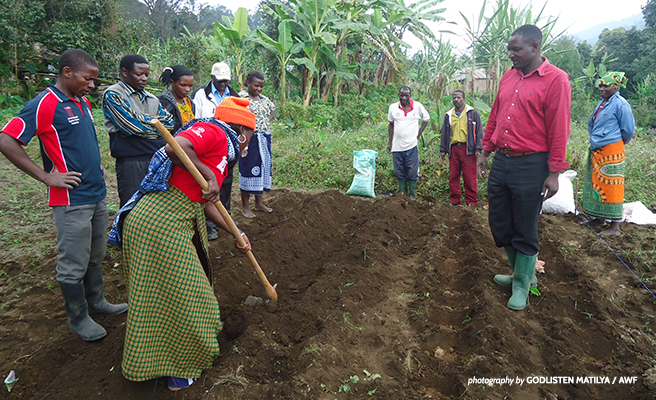How agriculture can protect biodiversity
Tanzania is known for its wildlife tourism, but in reality, 91 percent of tourism arrivals in the country head to northern Tanzania. The southern swath of Tanzania, with its fertile soils and temperate weather, is prime agriculture country.
Even so, making ends meet is not easy for the smallholder farmers who make up 80 percent of the region’s population. The average household in southern Tanzania—which averages six people—earns only about US$300 per year. Take Frank Adamson. For the past 20 years, he has been eking out an existence as a potato farmer. Like other farmers here, Frank struggled to get the best prices for his crops. At the same time, his harvests were declining. Insects were invading his fields, and a lack of sustainable farming methods had reduced the output of his land.
Frank took out loans to buy fertilizers and pesticides, which he thought would maximize his yields. He was unknowingly making things worse: The chemicals in combination with his agricultural practices were leaking nutrients from the soil. Each subsequent year, Frank would take out more loans for fertilizers and pesticides.
“Each year, harvests were declining for Frank and other farmers, while production costs were increasing,” says Godlisten Matilya, who oversees AWF’s conservation programs in the Mbeya region of southern Tanzania. “They ended up in a vicious cycle of debt.”

An entry point for conservation
But not only have the chemical fertilizers added to the debts of farmers like Frank, they have also caused environmental havoc. The chemicals have leaked into Lake Nyasa, which provides water for the region. Lake Nyasa takes more than 700 years to cycle through and replace all of its water.
“Agriculture presents the greatest threat to biodiversity conservation in southern Tanzania,” says Matilya. “Yet agriculture is the No. 1 income generator in southern Tanzania.”
So rather than try to convince longtime farmers to not farm, AWF instead decided to use agriculture as an entry point for conservation. We identified 181 demonstration farmers—including Frank—willing to try new sustainable farming techniques. Then we gave them training and other support.
AWF taught farmers how they can use locally available raw materials to make environmentally friendly farm inputs such as organic pesticides, compost fertilizer and farmyard manure. Farmers were further taught other sustainable yet profitable crop-production methods that allowed full use of their plots while conserving soil, water and beneficial organisms. On average, switching to organic methods shaved production costs by a whopping 80 percent. For instance, what used to cost TZS 3800 (about US$1,900) per acre with chemical fertilizers now only cost TZS 80,000 (US$40) per acre through composting.
Farmers like Frank were also having trouble getting the best prices for their crops at local markets. AWF therefore linked potato farmers to a market information network provided by Vodacom Telephone Company. This network, dubbed the Vodacom Agriculture Club, connects farmers to vendors who buy the potatoes in bulk, directly from the farms, and sells them in larger markets. With this new market linkage, post-harvest loss for potato farmers has declined by some estimated 30 percent.
For Frank, being a demo farmer has made a tremendous difference in his, and his family’s, life. In the past, he used to harvest 24 bags of potatoes per acre, earning him US$660. In his first season as a demo farmer, he harvested 72 bags per acre, making $1,980—a three-fold increase. With the extra income, Frank was able to install electricity in his house. He had enough money left over to buy the necessary seeds and other items for the following season without taking out a loan—breaking the vicious cycle of debt he had long been in.
And, with Frank and other demo farmers having agreed to share their newfound training with their neighbors, the impacts—both from the livelihood and conservation perspectives—look to spread at a rapid rate. “If we take the example from another AWF project area, we can expect that up to 1,600 to 2,000 smallholder farmers will be switching to sustainable methods every year,” concludes Matilya.
>See how AWF is also working with farmers in north-central Tanzania to encourage conservation